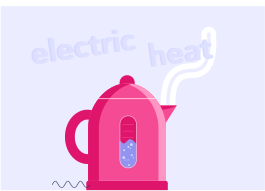YOU ARE LEARNING:
Efficiency

Efficiency
In this lesson we will cover the concept of efficiency and calculate it for appliances that deals with energy.
In this lesson, we will look at what we mean by efficiency and how to calculate it.
Look at this lamp. The purpose of it is to provide light. When it is switched on, it heats up quite a lot. Do you think the lamp will be 'more' or 'less' efficient when it gets very hot?


Useful energy and wasted energy
The energy that devices (like lamps) transfer into the energy that they are supposed to create (like light energy) is called useful energy. Any energy that is transferred into a different kind of energy is referred to as wasted energy (like heat).

Efficiency tells us what fraction of the energy we put into an appliance is transferred to useful energy.
Lamp 1 converts almost all of the electrical energy into light energy. Lamp 2 converts just a little bit of energy into light energy. Which lamp is more efficient?

Is there such a thing as 100% efficient appliance, do you think? Answer yes or no.

In fact...
it is impossible to avoid wasting at least some kind of energy during energy transfer, so there is no such thing as a 100% efficient appliance!
What do we call the energy we give an appliance?

Can you guess which expression roughly gives the efficiency of an appliance?

Calculating efficiency
We calculate the efficiency of any energy transfer...
by dividing the useful output energy transferred by the total amount of input energy transferred: Efficiency=TotalInputEnergyUsefulOutputEnergy
To calculate the efficiency as a percentage...
multiply this equation by 100:Efficiency=TotalInputEnergyUsefulOutputEnergy×100
Do you think efficiency can ever be larger than 100%? Answer 'yes' or 'no'.

If you forget which way round output and input energy go in the equation...
then remember that your answer must always be less than or equal to 1 (or 100%). So if your answer for efficiency is greater than 1, your equation is upside down!
A kettle is being used to heat up some water. 15,000J of thermal energy is transferred by the kettle. 12000J is actually transferred into the water. Calculate the efficiency of the kettle.

What is the efficiency of a light bulb which requires 200,000J to work, but which only transfers 150,000J into light?

Power is measured in Watts, which is equal to Joules per second. Now, how is power (P) related to energy (E)?

Out of these options, which do you think are good ways to increase efficiency? Pick all the options you think are correct.

You can select multiple answers
To sum up!
Efficiency is the proportion of the total input energy given to a device that is transferred into useful output energy.
efficiency=TotalEnergyInputUsefulEnergyOutput
Efficiency can also be calculated from the power input and output of a device
efficiency=TotalPowerInputUsefulPowerOutput
To find efficiency as a percentage, simply multiply the decimal by 100
efficiency×100=%
Finally, you can increase the efficiency of a system by reducing energy wastage.
The more efficient a device is, the less energy it will use because the less energy it will waste.
